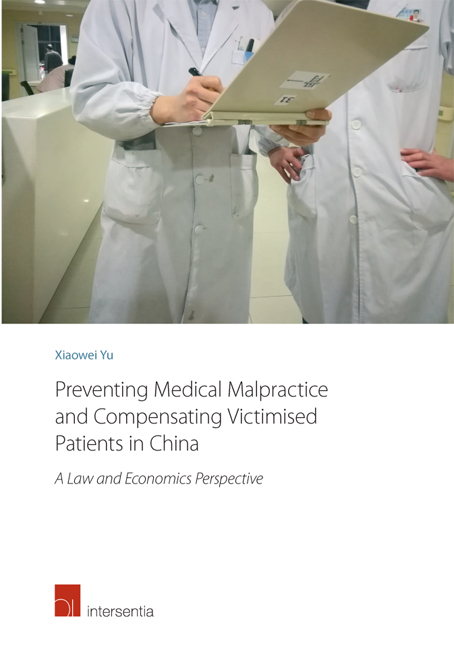 Preventing Medical Malpractice and Compensating Victimised Patients in China
Preventing Medical Malpractice and Compensating Victimised Patients in China Book contents
- Frontmatter
- Acknowledgements
- Contents
- Abbreviations
- List of Figures and Tables
- Chapter 1 Introduction
- Part I Legal Remedies for Medical Malpractice in China
- Part II Economic Theories and Empirical Evidence
- Introductory Note
- Chapter 7 Preventing Medical Errors through Tort Law – Theoretical Models
- Chapter 8 Preventing Medical Errors through Tort Law – Empirical Evidence and Updated Models
- Chapter 9 Preventing Medical Errors through Alternative Regimes
- Chapter 10 The Fault-Based Compensation Mechanisms for Iatrogenic Injuries
- Chapter 11 Medical Compensation Mechanisms Not Based on Fault
- Part III Applying the Economic Observations to China
- Summary
- Bibliography
- Appendix 1 Legislation
- Appendix 2 Cases
- Appendix 3 Semi-Structured Interviews
- Valorisation Addendum
- Curriculum Vitae
Chapter 7 - Preventing Medical Errors through Tort Law – Theoretical Models
from Part II - Economic Theories and Empirical Evidence
Published online by Cambridge University Press: 29 September 2018
- Frontmatter
- Acknowledgements
- Contents
- Abbreviations
- List of Figures and Tables
- Chapter 1 Introduction
- Part I Legal Remedies for Medical Malpractice in China
- Part II Economic Theories and Empirical Evidence
- Introductory Note
- Chapter 7 Preventing Medical Errors through Tort Law – Theoretical Models
- Chapter 8 Preventing Medical Errors through Tort Law – Empirical Evidence and Updated Models
- Chapter 9 Preventing Medical Errors through Alternative Regimes
- Chapter 10 The Fault-Based Compensation Mechanisms for Iatrogenic Injuries
- Chapter 11 Medical Compensation Mechanisms Not Based on Fault
- Part III Applying the Economic Observations to China
- Summary
- Bibliography
- Appendix 1 Legislation
- Appendix 2 Cases
- Appendix 3 Semi-Structured Interviews
- Valorisation Addendum
- Curriculum Vitae
Summary
INTRODUCTION
This Chapter is intended to answer the question how to prevent medical errors efficiently through tort law (part of Sub-question (2-a)). Calabresi divided the goal of accident law into three sub-goals: “primary cost avoidance” or prevention (to reduce the frequency and severity of accidents and the costs of precautions); “secondary cost avoidance” or compensation (to reduce the economic dislocation suffered by victims when an accident nonetheless happens; and “tertiary cost avoidance” (to reduce the costs of administering the systems that are intended to reduce primary or secondary costs). As far as error prevention is concerned, efficiency requires that Calabresi's primary costs should be reduced without incurring too high tertiary costs. It should also be noted that this chapter will answer the research question from a theoretical point of view.
This Chapter will begin with a brief introduction to the economic model of tort law (Section 2). Since China adopts fault-based tort liability to deal with medical malpractice issues, particular attention will be paid to the economic model under negligence. In Section 3, the basic economic model of the negligence rule will be applied to medical malpractice issues, discussing how the malpractice system (incl. the standard of care, causation, rules of evidence, the law of damages, and dispute resolution) should be designed so that both primary and tertiary accident costs could be minimised. The final Section 4 concludes.
THE CLASSIC MODEL OF TORT LAW
INTRODUCTION
The classic accident models of tort law attempt to explain how to minimise Calabresi's primary accident costs. Calabresi took it “as axiomatic that the principal function of accident law is to reduce the sum of the costs of accidents and the costs of avoiding accidents.” Later, Brown developed a unified economic model of liability which takes into account the care taking of the injurer and the victim simultaneously. In contrast, Shavell made a clear distinction between unilateral accidents (where only the injurer can affect accident risk) and bilateral accidents (where both the injurer and the victim can contribute to the occurrence of an accident) and analyses them separately. Moreover, Shavell took into account two kinds of decisions that may affect accident risk – care levels and activity levels.
- Type
- Chapter
- Information
- Preventing Medical Malpractice and Compensating Victimised Patients in ChinaA Law and Economics Perspective, pp. 211 - 252Publisher: IntersentiaPrint publication year: 2017
